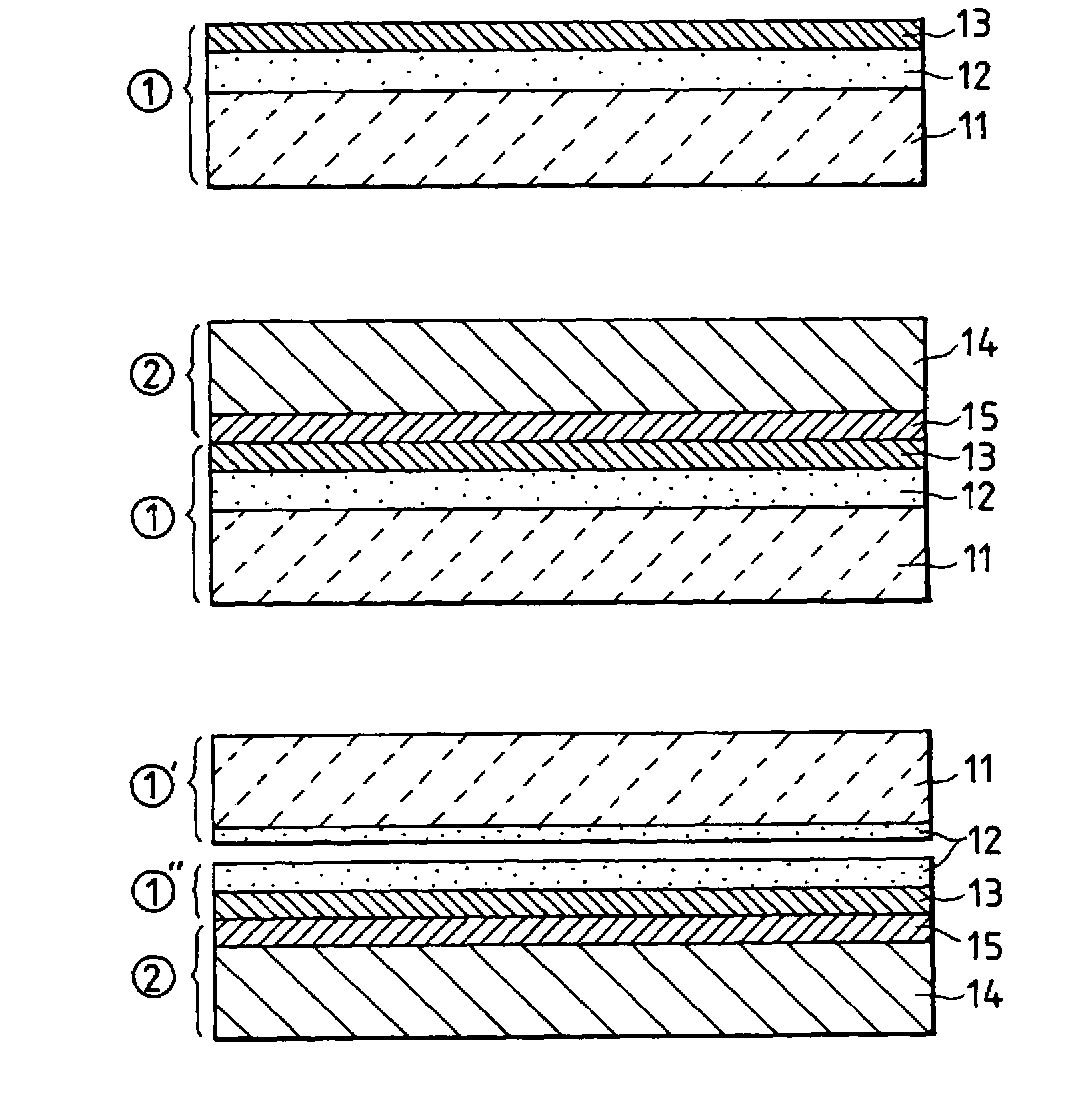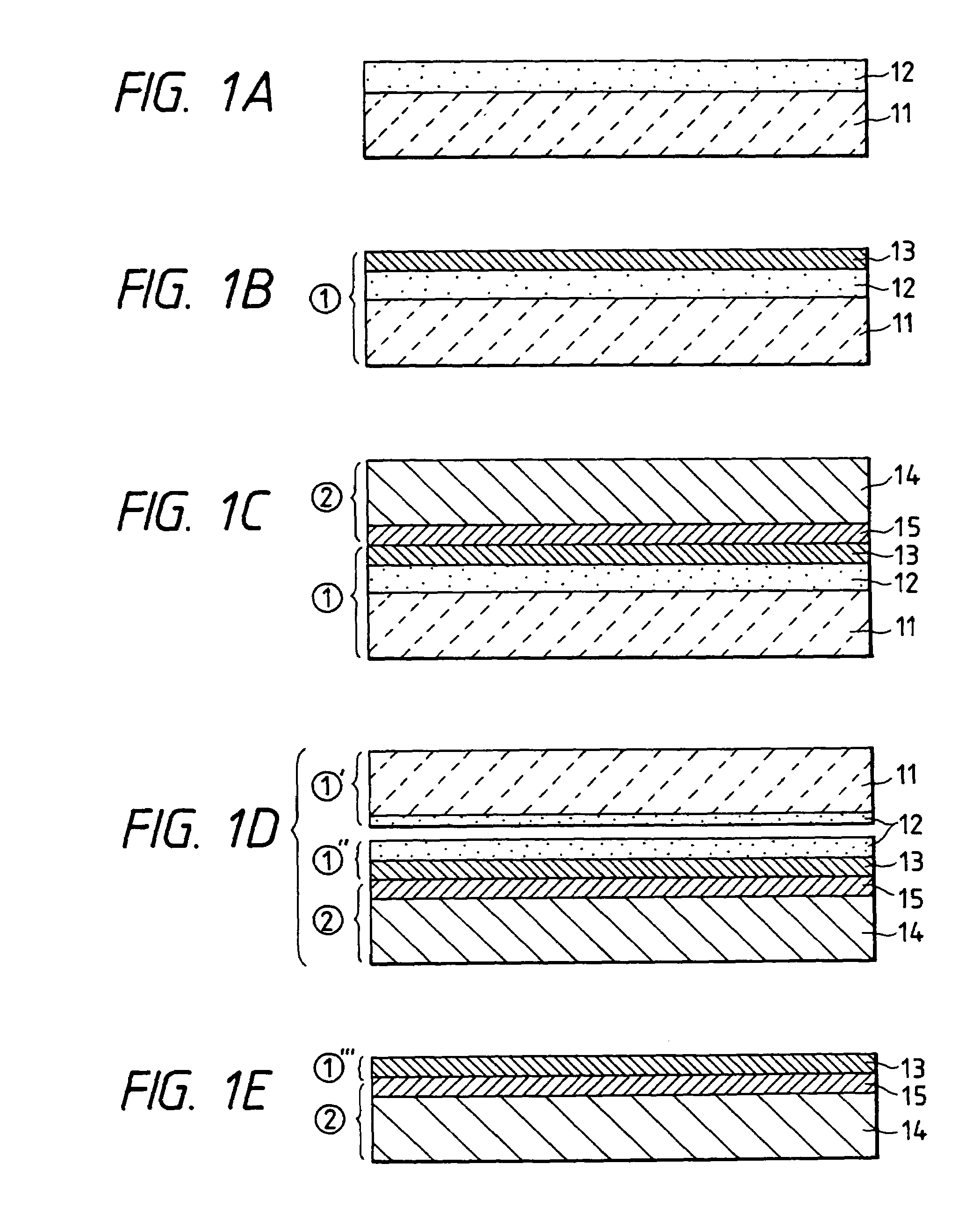Process for production of semiconductor substrate
a technology of semiconductor substrates and processing methods, applied in semiconductor devices, semiconductor/solid-state device details, electrical devices, etc., can solve the problems of difficult formation of large-area substrates, limited application fields of soi techniques, and high cost of soi techniques, so as to achieve high quality, lower cost, and high productivity.
- Summary
- Abstract
- Description
- Claims
- Application Information
AI Technical Summary
Benefits of technology
Problems solved by technology
Method used
Image
Examples
embodiment 1
[0054]A first monocrystalline Si substrate 11 is made porous at the surface to form a porous layer 12 as shown in FIG. 1A. Then, nonporous monocrystalline Si layer 13 is formed on the porous Si layer 12 as shown in FIG. 1B.
[0055]Another Si supporting substrate 14 is brought into contact with the nonporous monocrystalline Si layer 13 with interposition of an insulative layer 15 at room temperature as shown in FIG. 1C, and then the contacted matter was subjected to anode coupling, compression, heat treatment, or combination thereof to bond tightly the Si supporting substrate 14 and the monocrystalline layer 13 with interposition of the insulative layer 15. The insulative layer 15 may be formed preliminarily on either one of the monocrystalline Si layer 13 or the Si supporting substrate 14, or the three sheets may be bonded with an insulative thin film interposed.
[0056]Subsequently, the substrates are separated at the porous Si layer 12 as shown in FIG. 1D. On the Si supporting substra...
embodiment 2
[0063]A first monocrystalline Si substrate 21 is made porous at the surface to form a porous layer 22 as shown in FIG. 2A. Then a nonporous monocrystalline Si layer 23 is formed on the porous Si layer 22 as shown in FIG. 2B.
[0064]A light-transmissive supporting substrate 24 is brought into contact with the monocrystalline Si layer 23 with interposition of an insulative layer 25 at room temperature as shown in FIG. 2C, and then the contacted matter was subjected to anode coupling, compression, heat treatment, or combination of the treatment to bond tightly the light-transmissive supporting substrate 24 and the monocrystalline layer 23 with interposition of the insulative layer 25. The insulative layer 25 may be formed preliminarily on either one of the monocrystalline Si layer or the light-transmissive supporting substrate 24, or the three sheets may be bonded with interposition of an insulative thin film.
[0065]Subsequently, the substrates are separated at the porous Si layer 22 as s...
embodiment 3
[0071]A first monocrystalline Si substrate 31 is made porous at the surface to form a porous layer 32 as shown in FIG. 3A. Then a nonporous monocrystalline compound semiconductor layer 33 is formed on the porous Si layer 32 as shown in FIG. 3B.
[0072]Another Si supporting substrate 34 is brought into close contact with the monocrystalline compound semiconductor layer 33 with interposition of an insulative layer 35 at room temperature as shown in FIG. 3C, and then the contacted matter was subjected to anode coupling, compression, or heat treatment, or combination of the treatments to bond tightly the Si supporting substrate 34 and the monocrystalline layer 33 with interposition of the insulative layer 35. The insulative layer 35 may be formed preliminarily on either one of the monocrystalline compound semiconductor layer or the Si supporting substrate 34, or the three sheets may be bonded with interposition of an insulative thin film.
[0073]Subsequently, the substrates are separated at...
PUM
| Property | Measurement | Unit |
|---|---|---|
| thickness | aaaaa | aaaaa |
| porosity | aaaaa | aaaaa |
| density | aaaaa | aaaaa |
Abstract
Description
Claims
Application Information
 Login to View More
Login to View More - R&D
- Intellectual Property
- Life Sciences
- Materials
- Tech Scout
- Unparalleled Data Quality
- Higher Quality Content
- 60% Fewer Hallucinations
Browse by: Latest US Patents, China's latest patents, Technical Efficacy Thesaurus, Application Domain, Technology Topic, Popular Technical Reports.
© 2025 PatSnap. All rights reserved.Legal|Privacy policy|Modern Slavery Act Transparency Statement|Sitemap|About US| Contact US: help@patsnap.com



